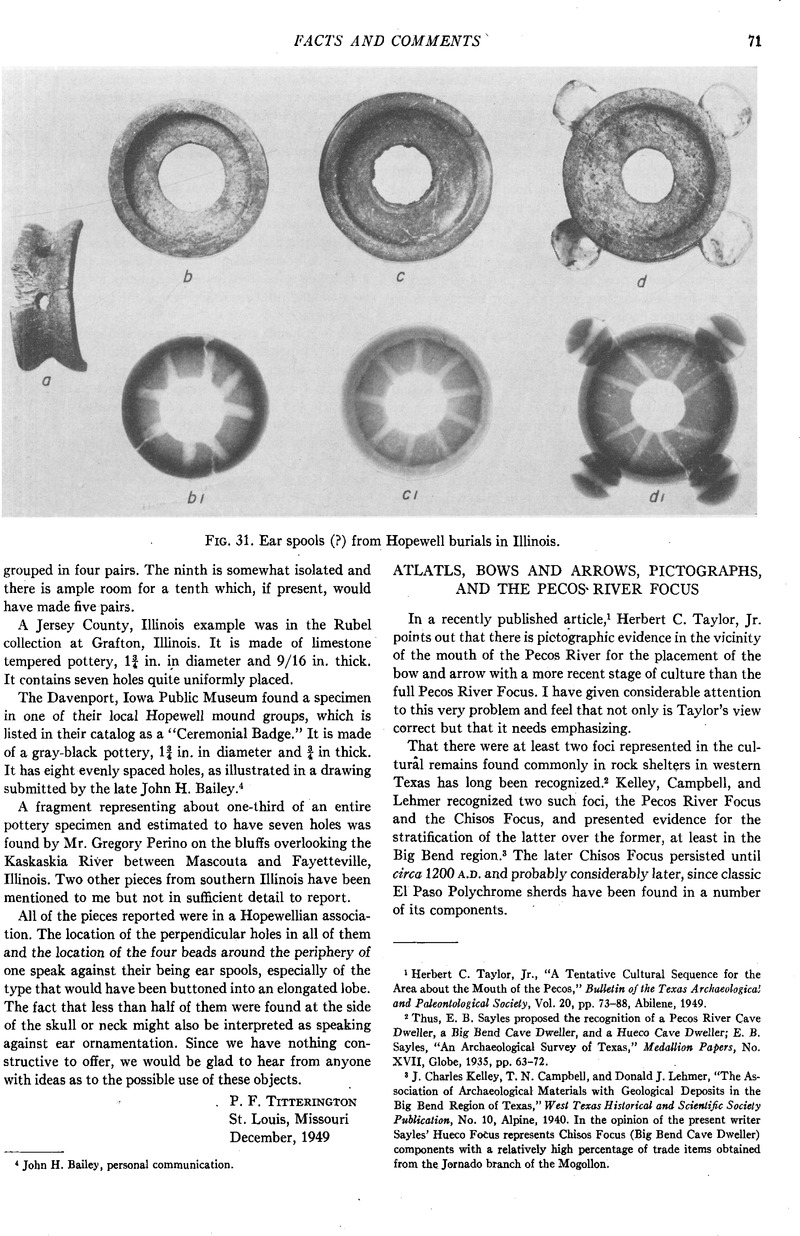Article contents
Atlatls, Bows and Arrows, Pictographs, and the Pecos River Focus
Published online by Cambridge University Press: 25 January 2017
Abstract

- Type
- Facts and Comments
- Information
- Copyright
- Copyright © The Society for American Archaeology 1950
References
1 Taylor, Herbert C., Jr., “A Tentative Cultural Sequence for the Area about the Mouth of the Pecos,” Bulletin of the Texas Archaeological and Paleontological Society, Vol. 20, pp. 73–88, Abilene, 1949.Google Scholar
2 Thus, E. B. Sayles proposed the recognition of a Pecos River Cave Dweller, a Big Bend Cave Dweller, and a Hueco Cave Dweller; E. B. Sayles, “An Archaeological Survey of Texas,” Medallion Papers, No. XVII, Globe, 1935, pp. 63–72.
3 Charles Kelley, J., Campbell, T. N., and Lehmer, Donald J., “The Association of Archaeological Materials with Geological Deposits in the Big Bend Region of Texas,” West Texas Historical and Scientific Society Publication, No. 10, Alpine, 1940 Google Scholar. In the opinion of the present writer Sayles’ Hueco Focus represents Chisos Focus (Big Bend Cave Dweller) components with a relatively high percentage of trade items obtained from the Jornado branch of the Mogollon.
4 Ibid. For a discussion of the Jornada branch see Lehmer, Donald J., “The Jornada Branch of the Mogollon,” University of Arizona Bulletin, Vol. 19, No. 2, Tucson, 1948.Google Scholar
5 See Charles Kelley, J., “The Cultural Affiliations and Chronological Position of the Clear Fork Focus,” American Antiquity, Vol. 13, No. 2, pp. 97–109, 1947 CrossRefGoogle Scholar, for a discussion of the probable age of these cultures.
6 J. E. Pearce and A. T. Jackson, “A Prehistoric Rock Shelter in Val Verde County, Texas,” The Universliy of Texas Bulletin, No. 3327; Anthropological Papers, Vol. 1, No. 3; Austin, 1933.
7 Holden, W. C., “Excavation of Murrah Cave,” Bulletin of the Texas Archaeological and Palaeontological Society, Vol. 9, pp. 48–73, Abilene, 1937.Google Scholar
8 Martin, George C., “Archaeological Exploration of the Shumla Caves,” Big Bend Basket Maker Papers, No. 3, San Antonio, 1933.Google Scholar
9 Setzler, Frank M., “A Prehistoric Cave Culture in Southwestern Texas,” American Anthropologist, Vol. 37, No. 1-1, pp. 104–10, Menasha, 1935 Google Scholar.
10 Pearce and Jackson, 1933, op. cit., p. 31.
11 Holden, op. cit., 1937, pp. 54 and 69, and PI. 8, A, 13–16. Kelley and Campbell (op. cit., 1940, p. 146, Note 217) point out that use of a different type of stratigraphic control might have revealed stratigraphic difference within the deposits in Murrah Cave.
12 Martin, op. cit., 1933. See pp. 26, 27, 55, 85, 86, 91, and Pls. X and XIX. Martin tries to explain the appearance of the arrows together with the atlatl by postulating that the nocked arrows were used with light atlatls. But other excavators, such as Setzler, have found bows as well as arrows.
13 Taylor, op. cit., 1949, p. 78.
14 Indeed, carefully prepared bars and balls of the pigments used in the pictographs occur in the refuse attributable to the focus.
15 Forrest Kirkland, “A Study of Indian Pictures in Texas,” Bulletin of Texas Archaeological and Paleontological Society, Vol. 9, Abilene, 1937, pp. 89–119; “A Description of Texas Pictographs,” Idem, Vol. 10, 1938, pp. 11–40; “Indian Pictures in the Dry Shelters of Val Verde County Texas,” Idem, Vol. 11, 1939, pp. 47-76; “A Comparison of Texas Indian Pictographs with Paleolithic Paintings in Europe,” Central Texas Archaeologist, No. 3, Waco, 1937, pp. 9–26.
15 Forrest Kirkland, “A Study of Indian Pictures in Texas,” Bulletin of Texas Archaeological and Paleontological Society, Vol. 9, Abilene, 1937, pp. 89–119; “A Description of Texas Pictographs,” Idem, Vol. 10, 1938, pp. 11–40; “Indian Pictures in the Dry Shelters of Val Verde County Texas,” Idem, Vol. 11, 1939, pp. 47–76; “A Comparison of Texas Indian Pictographs with Paleolithic Paintings in Europe,” Central Texas Archaeologist, No. 3, Waco, 1937, pp. 9–26.
16 Jackson, A. T., “Picture Writing of Texas Indians,” The University of Texas Publication, No. 3809; Anthropological Papers, Vol. 11; Austin 1938 Google Scholar. Also see Pearce and Jackson, op. cit., 1933.
17 A Prehistoric Hunting Cult of the Pecos River Focus, MS, 1949.
18 Kirkland calls the atlatl and dart in these depictions a “broken flowering plant.” That the darts shown in place with the instrument are actually darts cannot be doubted, however, since they are repeatedly shown piercing animals. The atlatl is just as obviously that, therefore.
- 6
- Cited by


